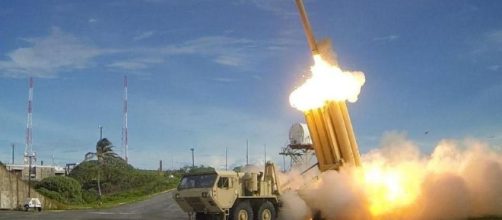On Tuesday, July 11, the US military successfully tested it's controversial THAAD missile system casting down an intermediate-range ballistic missile over the Pacific Ocean and demonstrating the improved capabilities of the warhead. The triumph of the US military is surely going to ease the nation's stress from North Korean threats.
About the launch
The launch of THAAD was based in Kodiak, Alaska while the target IRBM was dropped off from an aircraft flying north of Hawaii. The missile set a record being the first to be shot down an Intermediate-range ballistic missile.
IRBM or Intermediate range ballistic missile is a faster and challenging target to hit than shorter range missiles, according to the experts.
The US Missile Defense Agency on Tuesday quoted "The successful demonstration of THAAD against an IRBM-range missile threat bolsters the country's defensive capability against developing missile threats in North Korea and other countries."Due to the increasing stress with North Korean government over its weapons programme, the testing of THAAD was postponed for a long time.
The launch was originally scheduled months ago, but after the announcement of its deployment, the North Korean Government promised a "physical response," with state media expressing the "unwavering will of our army to deal a ruthless retaliatory strike."
Pyongyang, on July 4, asserted that it had carried out its first successful test of an intercontinental ballistic missile (ICBM) claiming that Hwasong-14 can hit "any part of the world." The US defense unit rejected the statement describing it as an intermediate range missile.
THAAD: A brief description
What exactly is THAAD?
- Built by American Military, THAAD stands for Terminal High Altitude Area Defense, formerly designated as Theater High Altitude Area Defense, an anti-ballistic missile defense system
- Devised to shoot down short, medium, and intermediate range ballistic missiles in their terminal phase
- Uses hit-to-kill approach to cast down enemy missiles.
- Interceptor is almost identical to the missiles built by North Korea.
- Has an operational range of 200 km with a lighting speed of Mach 8.24 or 2.8 km/s and can attain an altitude of 150 km.
- Developed after Iraq's Scud missile attacks during the Gulf War in 1991.
- Works on the impact made by its kinetic energy to destroy the other missile.
- Weighs 900 kilograms with a length and diameter of 6.17m and 34 cm respectively.
- Deployed in Guam and Hawaii by the US military as a safety measure from North Korean attacks. The deployment gained huge protests and criticism from China, which says the system's powerful radar can probe deep into its territory.
- Guided by Indium antimonide Imaging Infra-Red Seeker Head guidance system
- Built, designed and integrated by Lockheed Martin Space Systems


